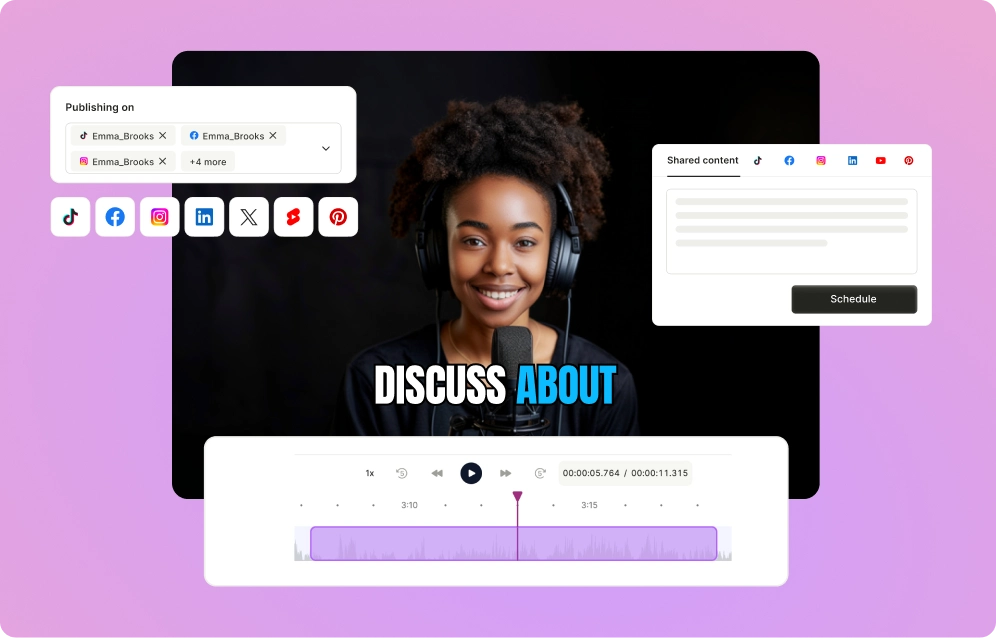Instagram Stories have become an integral part of the platform, allowing users to share ephemeral moments with their followers. However, the fleeting nature of these posts often leaves users wondering about the privacy implications of screenshotting them.
Many Instagram users have found themselves in a situation where they want to capture a Story post for future reference or to share with others. This desire to save content has led to questions about whether the original poster receives a notification when someone takes a screenshot of their Story.
To address these concerns and provide clarity on the topic, we'll dive into Instagram's current policies regarding Story screenshots and explore the reasons behind them.
By understanding how the platform handles this feature, users can engage with Stories more confidently and respectfully.
{{cta-richtext}}
Do You Get Notified When Someone Screenshots Your Instagram Story?
Short answer—No, you won’t be notified if someone screenshots your Instagram story.
This means that if you capture a Story for personal reference or to share with a friend, the creator will remain unaware of your action.
However, Instagram briefly experimented with a screenshot notification feature in 2018. During this test period, users received alerts when someone took a screenshot of their Story.
The feature was met with significant backlash from the Instagram community, as many users felt it infringed upon their ability to engage with content freely. As a result, Instagram quickly removed the feature and has not reintroduced it since.
And this feature has existed on Snapchat as long as someone can recall and mostly because Snapchat has branded itself as a platform to maintain privacy. It makes sense for them to have such a feature but Instagram stories is a way for people to share everyday updates.
Why Doesn't Instagram Notify About Story Screenshots?
User Backlash
Instagram's attempt to change how users save Stories conflicted with the usual unrestricted experience. People liked being able to save content quietly, so the notifications felt intrusive. Due to strong backlash, Instagram quickly dropped the feature, showing its commitment to user satisfaction and platform standards.
Promoting Engagement
Instagram aims to keep things lively and interactive. Sending notifications for Story screenshots could make users hesitant to save or share content, which would go against Instagram’s goal of a free-flowing, organic environment.
By skipping these notifications, Instagram helps ideas and creativity circulate more smoothly, improving the experience for everyone.
Technical Limitations
Taking screenshots is pretty tricky to track across all devices and apps. Think about it—there are tons of different phones, tablets, and apps out there, which makes it super hard to catch every screenshot reliably.
If Instagram tried this and messed up, they could get into hot water legally—users wouldn't be happy if their privacy was at risk. So instead of dealing with all that headache, Instagram just sticks to what works and skips the screenshot alerts altogether.
💡 Maximize your reach! Discover the Best Times to Post on Instagram to boost views and likes for ultimate Instagram success.
{{cta-richtext}}
When Does Instagram Send Screenshot Notifications?
Instagram's approach to notifications shifts when it comes to direct messaging, where privacy takes on a heightened role. The platform's algorithm has specific protocols for handling screenshots within its messaging features, distinct from its policy on Stories.
Disappearing Photos and Videos
For disappearing photos and videos sent through direct messages, Instagram provides notifications if these are screenshotted. Designed for temporary viewing, any attempt to capture these moments triggers an alert to the sender.
This mechanism underscores Instagram's commitment to preserving the ephemeral intent of such content, ensuring that users' expectations of privacy are respected.
Vanish Mode Chats
Vanish Mode adds another layer of privacy by allowing messages to disappear after a chat ends. In this mode, if a screenshot is taken, Instagram notifies the other participant, reinforcing the feature's focus on confidentiality. Vanish Mode is tailored for conversations that users wish to keep private, offering a safeguard against unintended captures.
Regular DMs, Posts, and Profiles
In contrast, Instagram does not notify users about screenshots of regular direct messages, posts, or profile pages.
This approach reflects the platform's aim to encourage interaction without imposing unnecessary restrictions. Users can freely capture these elements, maintaining the fluid and open nature of engagement on Instagram.
💡 Plan Ahead for Success! Discover the Complete Guide to Scheduling Instagram Posts and simplify your content management for maximum impact and growth.
Best Practices for Maintaining Privacy on Instagram
Make Your Account Private
Adjusting your account to private status is a straightforward yet powerful method to enhance your privacy on Instagram. This setting allows you to approve who follows you, ensuring that only those you trust can view your posts and Stories. Although it may limit your reach and ability to gain new followers, it offers a secure environment for sharing personal content. This trade-off is often worthwhile for those prioritizing control over their audience and the privacy of their shared moments.
Use "Close Friends" Lists
The "Close Friends" feature on Instagram provides a unique opportunity to share Stories with a handpicked group of followers. This feature is ideal for content meant for a select few, such as personal updates or sensitive topics. By creating a "Close Friends" list, you ensure that only a trusted circle can view your Stories, reducing the risk of unwanted screenshots or unauthorized sharing. This fosters a more intimate and secure sharing experience, allowing you to communicate more openly with those you trust.
Hide Stories from Specific Users
Instagram's privacy settings offer the flexibility to hide your Stories from certain users, which can be accessed through the Story Controls. This is particularly useful if you have privacy concerns about specific followers. By selectively restricting access, you maintain control over who sees your content, allowing you to share freely without worry. This feature empowers users to manage their audience dynamically, ensuring that their Stories are viewed only by those they deem appropriate.
Be Mindful of Sensitive Information
Being cautious about the information you share on Instagram is crucial to maintaining your privacy. Public posts and Stories can sometimes inadvertently expose personal details, which can be mitigated by using direct messaging for more private exchanges. By choosing to share sensitive information via direct messages, you ensure that only the intended recipient has access. This precaution helps protect your privacy while allowing for meaningful interaction.
Monitor Your Followers
Regularly reviewing your follower list is an essential practice to ensure your Instagram account remains secure. Removing or blocking accounts that raise suspicions helps safeguard your content and maintain a positive environment. This proactive approach not only protects your privacy but also enhances your Instagram experience by cultivating a community of genuine interactions. By keeping your follower list curated, you ensure interactions align with your personal or professional objectives.
💡Looking to land on the Instagram Explore Page? We’ve got you covered! Check out our 10 Proven Tips on How to Get on the Instagram Explore Page in 2024 and start boosting your reach today!
Capturing and Sharing Instagram Content Respectfully
Engaging with content on Instagram thoughtfully means recognizing the value of the creator's work and the intent behind its sharing. When a post or Story strikes a chord, the desire to share with others is understandable. Yet, this process should uphold the creator’s rights and the platform’s community standards.
Seeking Permission and Crediting Creators
Always approach the original creator to gain permission before taking a screenshot or sharing their work. This demonstrates respect for their creative effort and acknowledges their authority over its distribution. A polite message or comment can suffice for this request. Once approval is granted, ensure proper credit is given by tagging their account in your repost. This not only attributes the content to them but also amplifies their reach, reinforcing a community built on mutual respect and recognition.
Leveraging Instagram's Native Features
Instagram provides robust features designed for seamless content sharing, eliminating the need for screenshots. Use the "Share" button to circulate content within your network, preserving the creator’s original post and its associated interactions. This method ensures that the creator receives the full benefit of any engagement your sharing might generate, while also maintaining the integrity of the original post. By using these built-in tools, you support a culture of respectful sharing that acknowledges and respects the creator’s original work.
Honoring the Intent of Disappearing Content
Disappearing content, such as Vanish Mode messages, is crafted for temporary viewing. Respect the transient nature of these messages by refraining from capturing or saving them. This approach honors the sender’s intention for the content to remain private and ephemeral, fostering trust and security within the community.
By adhering to these privacy norms, you help maintain an environment where users feel comfortable sharing moments without concern over permanence or unauthorized use.
While Instagram's current policy allows for Story screenshots without notifications, it's essential to approach this feature with respect for the content creator and their intentions.
By engaging thoughtfully, seeking permission when appropriate, and utilizing Instagram's native sharing tools, you contribute to a community built on mutual trust and appreciation. As the platform continues to evolve, we at quso.ai (previously vidyo.ai) remain committed to providing you with the latest insights and tools to navigate the ever-changing landscape of social media storytelling – sign up now and let us help you elevate your content strategy!




.webp)


.webp)


